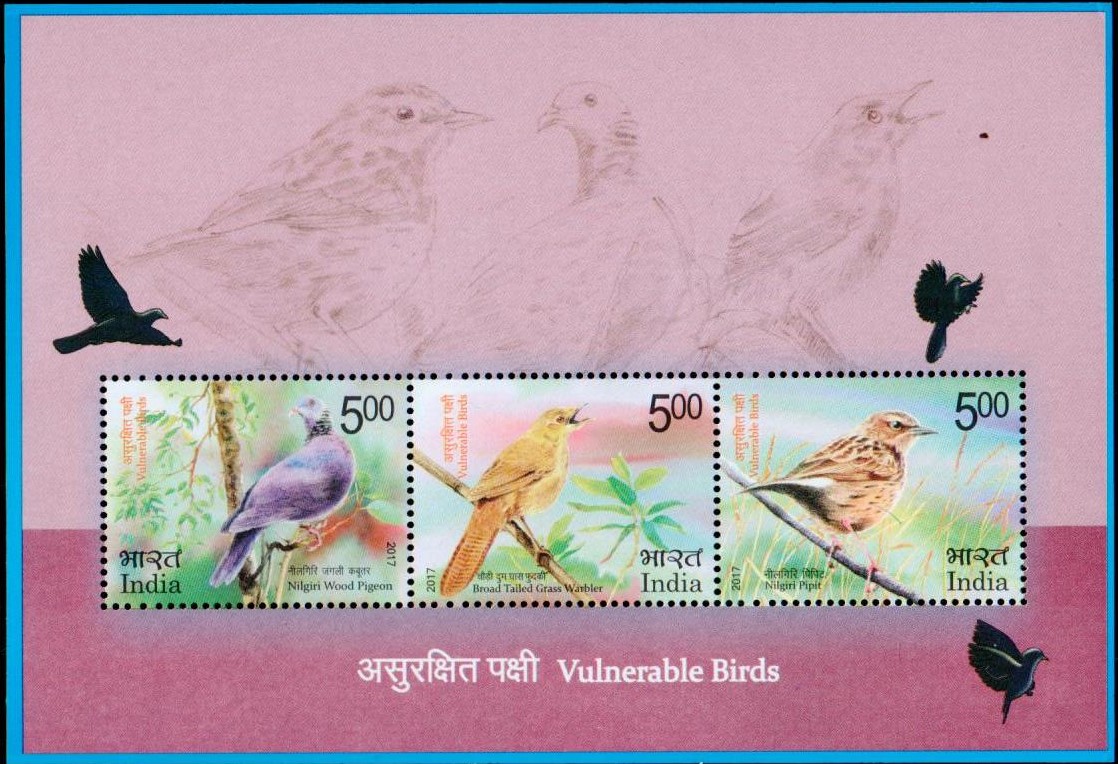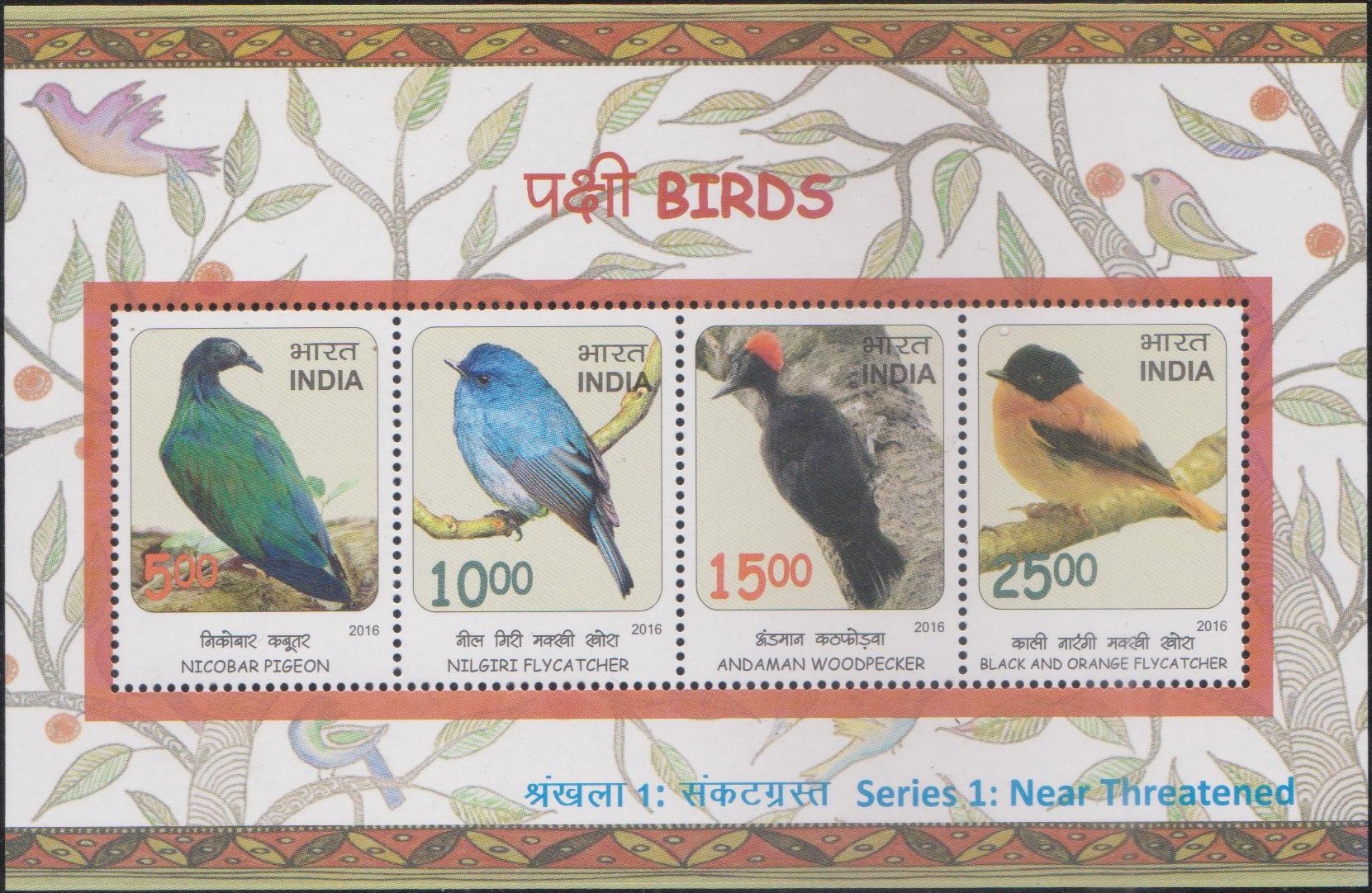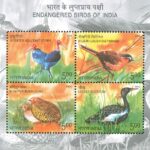
Vulnerable Birds of India 2017
Complete set of 3 nos. of commemorative postage stamps on the Vulnerable Birds : Nilgiri Wood Pigeon, Broad Tailed Grass Warbler and Nilgiri Pipit :



 Issued by India
Issued by India
Issued on Sep 18, 2017
Credits :
Stamp/Miniature Sheet/FDC/Brochure : Shri Suresh Kumar
Cancellation Cachet : Smt. Nenu Gupta
Type : Miniature Sheet, Mint Condition
Colour : Multi Colour
Denomination : 500 Paise (3)
Stamps Printed : 0.5 million each
Miniature Sheet Printed : 0.1 million
Printing Process : Wet Offset
Printer : Security Printing Press, Hyderabad
About :
- The International Union for Conservation of Nature and Natural Resources (IUCN) which is an international organization working in the field of nature conservation and sustainable use of natural resources has divided the Birds into Categories. The IUCN issues a Red List, in which IUCN categorizes species into nine different categories on the basis of rate of decline, population size, area of geographic distribution, and degree of population and distribution fragmentation. One such Category of Birds is “Vulnerable” (VU), wherein those Birds species comes which have high risk of endangerment in the wild.
- The Department of Posts is pleased to release a set of three stamps on the following three Vulnerable birds.
- Nilgiri Wood Pigeon / Columba elphinstonii (Sykes, 1833):
- This pigeon qualifies as Vulnerable owing to its small, declining population; a consequence of the widespread destruction of its forest habitat. This Bird is thought to be endemic to the hill-ranges of the Western Ghats, south-west India, occurring from north-west Maharashtra, through Karnataka and Goa, to southern Kerala and western Tamil Nadu. This Bird is a large pigeon with mostly chestnut-maroon upperparts and greyish head and underparts. Prominent black-and-white patterned hindneck. Uniform dark slaty tail. Juveniles have less distinct neck pattern and are duller above with chestnut fringing on mantle and wing-coverts. The species does not necessarily occur across all suitable forest patches in Sahyadri Tiger Reserve – a part of Northern Western Ghats, which is suggestive of possible overestimation in the current projected range of the species in Western Ghats. It is virtually confined to moist evergreen, semi-evergreen forest, and moist deciduous forest including densely wooded ravines and hollows (“sholas”), chiefly in foothills and mountains up to 2,250 m, but there have been an increasing number of records in the lowlands down to 20 m. Historically, it was hunted for food and sport, which probably contributed to its decline. Currently, the loss, degradation and increasing fragmentation of forest are a greater concern. It is legally protected in India and occurs in several protected areas. A remote sensing project is planned to attempt to delimit the range and assess rates of forest loss.
- Broad Tailed Grass Warbler / Schoenicola platyurus (Jerdon, 1844):
- This species has a small, fragmented, declining range and population as a result of the clearance and modification of grasslands. It therefore qualifies as Vulnerable. This Bird is endemic to the Western Ghats, India, where it is known from Maharashtra, Andhra Pradesh, Karnataka, Kerala and Tamil Nadu. Large, plain warbler with whitish underparts and broad, rounded tail. Rufescent-brown upperparts when breeding, but colder and greyer when plumage worn. Faint, dark cross-bars on tail and narrow, pale supercilium that extends to just behind eye. It inhabits dense, tall grass and reeds, interspersed with patchy scrub and bushes on open hillsides, sometimes on steep slopes, but particularly marshy or damp depressions around hilltops, at 900-2,000 m. It also occurs in dense screw pine swamps, lemon grass and dwarf dates and at the edges of forest. This species is threatened by the mismanagement of native shola grasslands, as these habitats are little valued and many areas have been planted with exotic tree species. It is known to occur in several protected areas, including Bramhagiris Wildlife Sanctuary, Aralam Wildlife Sanctuary, Eravikulam National Park, Periyar Tiger Reserve, Kalakkad-Mundanthurai Tiger Reserve, Neyyar Wildlife Sanctuary, Peppara Wildlife Sanctuary and Silent Valley National Park.
- Nilgiri Pipit / Anthus nilghiriensis (Sharpe, 1885):
- This species is listed as Vulnerable because it has a small range in which its habitat is severely fragmented and declining in extent and quality, which in turn is suspected to be driving a decline in its small population. This species is endemic to the Western Ghats of Kerala, Tamil Nadu and Karnataka, southern India. It is locally fairly common within its small range, particularly above 2,000 m. Surveys conducted in 2002-2004 found the species to be almost extinct at some former sites, suggesting that the population is in decline. It occurs on grassy upland slopes interspersed with bushes and trees, mainly above 1,500 m, and is commonest over 2,000 m, but sometimes descends to 1,000 m. The species has been observed to feed mostly on creeping grass in valleys, but to nest in marshy grasslands with slightly taller grasses and sedges, particularly near streams. Nilgiri pipit has broad deep buff to whitish supercilium, darker buff ear-coverts, sometimes some dark spots in malar region; crown and upperparts tawny-olive or warm grey-brown with greenish-yellow tinge; crown to mantle and scapulars heavily streaked blackish-brown, back to uppertail coverts streaked grey-brown. Remiges and wing coverts dark brown, with two wing bars. Tail dark brown. Throat, breast and flanks deep buff; belly paler buff, with blackish brown streaks on breast and flanks. Iris dark brown; bill blackish; legs pale pink or yellowish pink.
- Its grassland habitat is gradually being converted to plantations of tea, eucalyptus and silver wattle. The unintentional spread of wattle and invasive scotch broom to grasslands is another long-term threat. Livestock grazing and frequent fires also pose threats to the species.
- Text : Based on the material available on internet.








Nice like it.